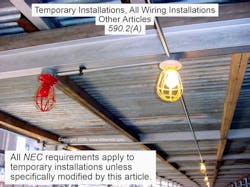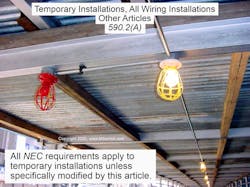Courtesy of www.MikeHolt.com. Based on the 2020 NEC.
Article 590 addresses the practicality and execution issues inherent in temporary installations, making them less time consuming to install and remove.
The requirements of Art. 590 apply to temporary power and lighting installations/removals, including power for construction, remodeling, maintenance, repair, demolition, and decorative lighting.
This Article also applies when temporary installations are necessary during emergencies or for tests and experiments [Sec. 590.3(C)]. But you can’t use temporary wiring just anywhere. It’s permitted for only:
- Construction, remodeling, maintenance, repair, or demolition of buildings, structures, or equipment.
- Activities like the preceding.
- Emergencies.
- Tests, experiments, and developmental work.
Temporary installations for carnivals, circuses, fairs, and similar events must be installed per Art. 525, not Art. 590.
After the construction is completed, emergency has passed, etc., you no longer require the temporary wiring. The justification for installing it is gone, so you must remove it [Sec. 590.3 (D)].
Temporary electrical power for decorative holiday lighting and similar purposes is permitted for a period of up to 90 days. Once that clock runs out, you must remove the temporary electrical power [Sec. 590.3(B)].
Not a replacement
Temporary wiring methods are acceptable only if approved by the authority having jurisdiction based on the conditions of use and any special requirements of the temporary installation [Sec. 590.2(B)].
Article 590 does not replace Chapters 1 through 4 of the NEC for temporary installations. If you have a temporary installation, you don’t just apply the requirements of Art. 590 and consider the installation Code-compliant. Instead, you apply the relevant requirements of Chapters 1 through 4, and check Art. 590 for modifications of those [Sec. 590.2(A)] (Fig. 1).
If installing a temporary service, you must do so per Parts I through VIII of Art. 230 as applicable [Sec. 590.4(A)].
If installing temporary feeders, you must provide overcurrent protection per Sec. 240.4 and Sec. 240.5 [590.4(B)]. If installing temporary branch circuits, you must provide overcurrent protection per Sec. 240.4 and Sec. 240.5 [Sec. 590.4(C)].
For feeders and branch circuits, you can use only these wiring methods:
(1) Type NM cable, Type SE cable, and flexible cords. You can use these in a building without height limitations or limitations by building construction type. Nor do you have to conceal them within walls, floors, or ceilings; they will be easier to remove if you don’t.
(2) Type SE cable. You can install it underground if you install it in a suitable raceway.
Receptacles
On a construction site, receptacles are not permitted on a branch circuit that supplies temporary lighting [Sec. 590.4(D)(1)]. This requirement is necessary so illumination is maintained, even when the receptacle’s GFCI-protective device opens.
15A and 20A receptacles installed in a wet location must be within an enclosure that is weatherproof when an attachment plug is inserted [Sec. 590.4(D)(2)]. The outlet box hood must be listed for extra-duty use. Nonlocking-type receptacles in a wet location must be listed as weather-resistant [Sec. 406.9(B)(1)].
Though the NEC doesn’t specify how many receptacles you need in a given area, you should put some thought into having enough that people don’t have to play portable cord games just to get their work done. For example, instead of a bank of receptacles in one central location, strategically run branch circuits out to where power is needed or is likely to be needed.
Disconnecting means
Install suitable disconnecting switches or plug connectors to permit disconnecting all ungrounded conductors of each temporary circuit [Sec. 590.4(E)]. If multiwire branch circuits are installed, they must disconnect all ungrounded conductors simultaneously; you can use identified handle ties for this purpose.
Lamp protection
Lamps (bulbs) must be protected from accidental contact by a suitable luminaire or lampholder with a guard [Sec. 590.4F)]. This requirement is less of a burden if you use LED luminaires since the lamps themselves are at 5V and don’t run hot. Best results in both safety and energy efficiency are achieved by using an integrated LED lighting product rather than a retrofit lamp screwed into a fixture designed for incandescent.
Splices
A box, conduit body, or other enclosure (with a cover installed) is required for all splices [Sec. 590.4G)].
Exception No. 1: On construction sites, a box is not required if the circuit conductors being spliced are all from:
(1) Nonmetallic multiconductor cord or cable assemblies, if the equipment grounding continuity is maintained with or without the box.
(2) Metal-sheathed cable assemblies terminated in listed fittings that mechanically secure the cable sheath to maintain effective electrical continuity.
Exception No. 2: On construction sites, a box is not required for GFCI-protected branch circuits that are permanently installed in framed walls and ceilings and are used to supply temporary power or lighting.
(1) A box cover is not required for splices installed completely inside of junction boxes with plaster rings.
(2) Listed pigtail-type lampholders can be installed in ceiling-mounted junction boxes with plaster rings.
(3) Finger-safe devices are permitted for supplying and connecting devices.
Physical protection
Cables and flexible cords must be protected from physical damage and from sharp corners and projections when the cables and flexible cords pass through doorways or other pinch points [Sec. 590.4(H)]. Cord protectors and related products are available for this purpose; don’t rely totally on that roll of duct tape.
Cable assemblies and flexible cords must be supported at intervals that ensure protection from physical damage [Sec. 590.4(J)]. Support must be in the form of staples, cable ties, straps, or other similar means designed not to damage the cable or flexible cord assembly. Flexible cords (other than extension cords) are not permitted to lie on the floor or the ground when used as branch circuits or feeders.
The support requirement for temporary cables is determined by the authority having jurisdiction based on the job-site conditions. You can’t use vegetation to support overhead branch-circuit or feeder conductors [Sec. 590.4(J)] (Fig. 2).
GFCI protection
GFCI protection is required for receptacles used for construction, remodeling, maintenance, repair, or demolition of buildings, structures, or equipment [Sec. 590.6(A)].
GFCI protection is required for:
- 15A, 20A, and 30A receptacles that are not part of the permanent wiring of the building. Section 590.6(A) requires 125V and 125/250V, 15A, 20A, and 30A receptacles to have GFCI protection. Section 590.6(B) requires all other receptacles used on temporary installations to be GFCI protected. This simply means all 125V and 125/250V receptacles used for temporary power require GFCI protection.
- 15A, 20A, and 30A receptacles that are being used as temporary power but are part of the permanent wiring of the building. Listed flexible cord sets or devices that incorporate listed GFCI protection can be used in addition to the required GFCI receptacles.
- 125V and 125/250V, 15A, 20A, and 30A receptacles that are part of a portable generator rated not greater than 15kW.
Receptacles other than those covered by Sec. 590.6(A)(1) through (A)(3) that supply temporary power used by personnel during construction, remodeling, maintenance, repair, or demolition of buildings, structures, equipment, or similar activities.
Overcurrent protective devices
Where previously used overcurrent protective devices are installed in a temporary installation, they must be examined [Sec. 110.3(A)] to ensure they have been properly installed/maintained and that there is no evidence of impending failure [Sec. 590.8(A)].
The phrase “evidence of impending failure” means there is evidence such as arcing, overheating, loose parts, bound equipment parts, visible damage, or deterioration. The phrase “properly maintained” means the equipment has been maintained per the manufacturer’s recommendations and applicable industry codes and standards.
References for manufacturers’ recommendations and applicable industry codes and standards include:
- NEMA AB 4, Guidelines for Inspection and Preventative Maintenance of Molded-Case Circuit Breakers Used in Commercial and Industrial Applications.
- NFPA 70B, Recommended Practice for Electrical Equipment Maintenance.
- NEMA GD, Evaluating Water-Damaged Electrical Equipment.
- IEEE 1458, IEEE Recommended Practice for the Selection, Field Testing, and Life Expectancy of Molded-Case Circuit Breakers for Industrial Applications.
Overcurrent protective devices for 277/480V services must be of the current-limiting type [Sec. 590.8(B)].
Different, not lower
Remember that mistakes with temporary installations can have permanent consequences. It is a common misconception that temporary wiring represents a lower standard of wiring than permanent wiring. In truth, it merely meets a different standard. The same rules of workmanship, ampacity, and overcurrent protection apply to temporary installations as to others.
These materials are provided by Mike Holt Enterprises in Leesburg, Fla. To view Code training materials offered by this company, visit www.mikeholt.com/code.
About the Author

Mike Holt
Mike Holt is the owner of Mike Holt Enterprises (www.MikeHolt.com), one of the largest electrical publishers in the United States. He earned a master's degree in the Business Administration Program (MBA) from the University of Miami. He earned his reputation as a National Electrical Code (NEC) expert by working his way up through the electrical trade. Formally a construction editor for two different trade publications, Mike started his career as an apprentice electrician and eventually became a master electrician, an electrical inspector, a contractor, and an educator. Mike has taught more than 1,000 classes on 30 different electrical-related subjects — ranging from alarm installations to exam preparation and voltage drop calculations. He continues to produce seminars, videos, books, and online training for the trade as well as contribute monthly Code content to EC&M magazine.



